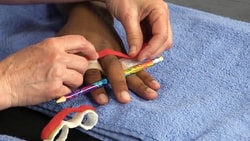Evidence Update: What's New in Flexor Tendon Rehabilitation?
March 5, 2019
3 min. read

Is there new evidence to support a particularly type of exercise regimen over another when it comes to producing safe and maximal range of motion of the digits after flexor tendon repair?
A recent systematic review by Nieduski and Powell1 compared nine studies employing early active motion (EAM) or true active flexion as opposed to early passive or place-and-hold flexion to determine the superiority of one exercise regimen to another. Their primary outcome measure was total active motion (TAM).
Early Active Motion
Peck, et al.2 and Higgins and Lalonde3 have published studies using progressive protocols that modify the position of the hand in the protective orthosis after flexor tendon repair surgery. They decreased the degree of metacarpopal flexion to 30 and also incorporated a hand-based orthosis either immediately after surgery or at the two-week time frame.
Peck, et al. compared wrist mobilization with immobilization and allowed light use of the affected hand in the immediate postoperative phase. In this study, the researchers found that there was no statistically significant difference between the two groups in TAM or ruptures at twelve weeks. They did find that the group with the hand-based orthosis had statistically significant improvements in DIP flexion and PIP extension as compared with those who wore a forearm-based orthosis.
Early Passive Flexion and Place and Hold
Four studies compared early passive flexion and place-and-hold protocols. One of the studies provided moderate evidence that a place-and-hold approach yields significantly better TAM at eight weeks than passive range of motion, but only in patients with two-strand zone two repairs.1
Systematic Review Findings
The Nieduski and Powell study found that:
Tendon repair strength of at least four strands is necessary to withstand the force of true active motion.
There is moderate- to high-level evidence that place-and-hold exercises provide better outcomes than passive flexion protocols, including Kleinert and modified Kleinert, for patients with two- to six-strand repairs.
Patients older than 30 years with a two-strand repair appear to have greater TAM at twelve weeks with a true active protocol than those who perform passive flexion.
Although the literature continues to move toward progressive protocols with true active motion and decreased immobilization of the wrist,2, 3 it is important to recognize that well-designed intervention studies to support those regimens do not yet exist.
What Does This Mean for Therapists?
Therapists must keep up to date with the evidence to determine when to modify practice patterns. It is also imperative that therapists receive information from the physician regarding the tendon repair strength. The Manchester protocol employed by Peck, et al. uses a hand-based protective orthotic, and they found no greater tendon ruptures in the group that used the hand-based orthotic.
Below, watch Kristin Valdes discuss place-in-hold mobilization for flexor tendon rehabilitation in a short clip from her MedBridge course, Flexor Tendon Rehabilitation of the Hand and Wrist.






